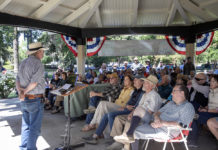The West Sonoma County Union High School District (WSCUHSD) set conditions at its March 10 board meeting to start small cohorts for prioritized student groups on March 29 and pursue an overall shift to a hybrid model of distance and on-campus education for the week of April 12-19.
The board also unanimously authorized the district to secure more air purification systems and some audio-visual technology needed to return to school at the March 10 meeting.
“We believe, in talking to the district staff and administrators, that we can have all of the things in place to start by April 12,” Superintendent Toni Beal said.
The small instructional cohorts starting earlier would serve students with disabilities, English Language Learners, foster youth and homeless students on a schedule “individualized by student needs and teachers’ schedule,” she said.
Beal said other prioritized groups include students who are disengaged, at risk of abuse, neglect or exploitation and students without high-speed internet access or computing devices.
Assembly and Senate Bill 86 sets some of the pacing for the district’s ambitions, offering $2 billion for in-person instruction support and $4.6 billion set aside for expanded learning purposes for the state’s school districts that meet its timeline and other requirements, Beal said.
The county was still in the purple, most restrictive tier when trustees approved plans to reopen if the county holds a case rate between one and seven per 100,000 people for five days and so long as all WSCUHSD staff and support providers have had the chance to receive COVID-19 vaccinations.
Since then, Sonoma County entered the red tier for the first time March 14 under the state’s recent move to let counties downgrade with a COVID-19 daily case rate of 10 instead of seven per 100,000 people.
Beal communicated to Sonoma West Times & News on March 19 that she will need to bring an updated resolution to align with the latest tier guidance from the state.
Meanwhile, Director of Human Resources Mia Del Prete said all district staff have been offered the opportunity to get a vaccine.
Bringing the hybrid model to life
The superintendent shared some scheduling possibilities the district is exploring to bring students back onto campus, like organizing comprehensive high school students into two main cohorts attending in-person classes on alternate days of the week.
One consideration for Laguna High School students would be to alternate which periods would be held in-person and which would be taught over distance-learning. For Analy and El Molino students, one possibility would be to have one main cohort meet Mondays and Tuesdays and the other Thursdays and Fridays, with a full cleaning day the Wednesday between groups, Beal said.
About one third of families responding to a district survey requested to remain on distance learning among the roughly 1,400 responses received as of March 10, she said.
“At this point, the students who are choosing to stay on distance-learning would follow the same schedule as the students that are in the classrooms,” Beal said. “So, their schedule would be altered based on the fact that they would be doing distance learning at the same time as students are having learning happen in the classroom.”
She said county mental health recommendations suggested limiting students to three stable cohort groups a day and an extracurricular activity and that the district seeks to limit mingling as much as possible to minimize risk of COVID-19 exposure.
The district’s facilities have been largely prepared for a hybrid return since August, according to Beal, and the board approved the emergency procurement of air purifiers and other products for the schools to reopen safely.
Director of Facilities and Bond Construction Management Jennie Bruneman said COVID-19 relief funds would fund the $110,000 cost of more air purifiers so schools would be ready for students by April 12.
“We have gone through every single classroom across all campuses. We have measured the classrooms in terms of square feet. We have marked off and delineated where every desk will go,” she said, crediting “our amazing custodial grounds and maintenance staff” and Facilities and Bond Construction Coordinator Denise Fisher.
“So, the ideal situation would be to have all doors and windows open to allow as much passive ventilation as humanly possible, but we have parts of our campuses that don’t currently have air conditioning,” she said. “Because it can get a bit cold, we might encourage people to dress warm,” Bruneman added later.
She said the district already received a grant for roughly $54,000 for air purification units that have since been installed, so the current objective is to get more units installed at any campus location that lacks air conditioning, such as the main building at Analy High School.
In the meantime, the facilities and maintenance staff are placing classroom capacity signs at their doors, she said, “and that can range anywhere from our smallest classrooms, which are just shy of 600 square feet, being six people in the room to our larger classrooms that could be upwards of 2,000 square feet, for 14 to 16 people (that) could be in the classroom.”
Many, many state funding timelines and requirements
Assembly and Senate Bill 86 offers $2 billion for in-person instruction support and $4.6 billion set aside for expanded learning purposes for school districts that meet its timeline and other requirements, Beal said.
The California Department of Education (CDE) will inform the state’s local education agencies, like WSCUHSD, how much its estimated allocation of the state funds will be within 15 days of the legislation’s effective date.
The California Legislative Information government website states the bill was approved by Governor Gavin Newsom on and filed with the Secretary of State on March 5, “to take effect immediately as a bill providing for appropriations related to the Budget Bill,” according to its legislative counsel’s digest.
The district needs to start in-person education by May 15 to access any funding whatsoever from the in-person instruction grant that hybrid models are still eligible for, she said.
The in-person instruction grant can fund in-person instruction-related costs like COVID-19 testing, personal protective equipment, ventilation and health and safety-related site upgrades. The funds can also be used for social and mental health support services and the certificated and classified salaries for new employees hired to provide those services, Beal said.
Now that the county is in the red tier, WSCUHSD must offer in-person learning for at least one full grade of students in addition to the prioritized student groups, the superintendent said. Districts have some flexibility in choosing how to phase grades back onto school grounds, according to Beal.
She said the district needs to certify that it meets the requirements in a form the California Department of Education (CDE) hasn’t actually developed yet. Funding starts the day in-person learning starts and decreases the later schools reopen from April 1 to May 15, so WSCUHSD won’t get the maximum funding amount available with its target start date of April 12, Beal said.
The grant funding for in-person instruction would be available through Aug. 31, 2022, delivered in two payments, she said. The first half would come in May, 2021 and the second in August, 2021, issued proportionately to the district’s Local Control Funding Formula (LCFF), Beal said.
The in-person instruction grant requires asymptomatic testing for participating staff and students unless the district reopens before March 31 or the board approves a reopening plan and posts the COVID-19 Safety Plan online, according to Beal’s presentation.
The superintendent said the district was working to partner with Valencia Labs to provide student and staff testing, potentially on a weekly basis.
Next, Beal said the $4.6 billion in state funding for grants is for developing a learning recovery program, addressing achievement gaps. The grant would go towards summer school or intersessional programs, tutoring, counseling, other social and emotional supports, meals for eligible students and technology access hubs.
These programs would largely focus on the same prioritized students — English Learners, foster youth, homeless students, credit-deficient students, those at risk of abuse, neglect or exploitation and others.
Beal said at least 85% of the district’s apportionment must fund instructional learning time and supports, 10% of which is specifically for hiring paraprofessionals to work with English Learners and students with exceptional needs. She said as much as 15% of the grant can fund preparation for in-person education or distance-learning instruction, like if WSCUHSD needed to stick to a hybrid model through summer.
The grant money can be spent through Aug. 31, 2022, “which means we could provide these expanding learning opportunities during the school year to assist any of our students that qualify under this grant,” Beal said.
To access the grants, the district needs to adopt a board-approved spending plan by June 1, she said. According to her presentation, the spending plan must be submitted to the Sonoma County Office of Education within five days of the plan’s approval, although the Superintendent of Public Instruction has yet to develop the plan’s template.
The state funding also requires the district make available on its website how many students are learning full-time in person, in hybrid and over distance, how many staff work on-site, and other information that needs to be site-specific, per Beal’s presentation.
This information is due each month to the California Department of Public Health starting March 15 and the district must inform the local health officer within 24 hours of finding out any staff or students test positive for COVID-19, the presentation added.
Furthermore, the board of trustees has already approved the COVID-19 Prevention Plan (CPP) required to reopen, since posted to the district’s website, she said.
Meanwhile, a COVID-19 Safety Plan (CSP) must be tailored to each site, outlining plans for cohorts, transportation and entering and exiting campuses. “And that safety plan is under development right now,” she said. Beal said the CSP must meet the board’s approval and make it onto the website five days prior to reopening, so another special board meeting will need to make it on the calendar.









